-
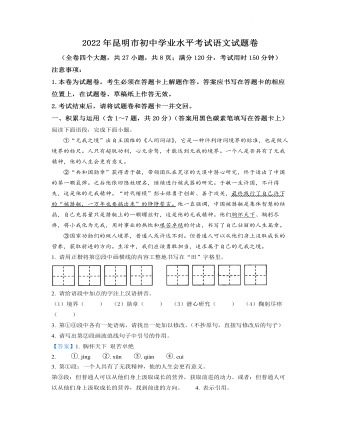
2022年云南省昆明市中考语文真题(解析版)
秦王谓唐雎曰:“寡人以五百里之地易安陵,安陵君不听寡人,何也?且秦灭韩亡魏,而君以五十里之地存者,以君为长者,故不错意也。今吾以十倍之地,请广于君,而君逆寡人者,轻寡人与?”唐雎对曰:“否,非若是也。安陵君受地于先王而守之,虽千里不敢易也,岂直五百里哉?”
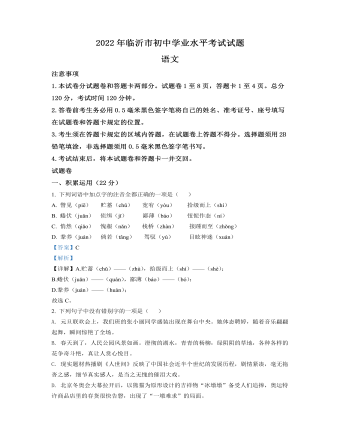
2022年山东省临沂市中考语文真题(解析版)
这种吸入式接种流程像喝咖啡。每人一只口杯,在酷似咖啡机的雾化器前接一杯雾化的疫苗,深吸气,保持5秒,正常呼吸,疫苗就接种完成了。
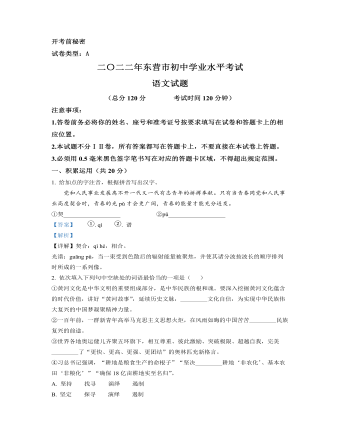
2022年山东省东营市中考语文真题(解析版)
夫所为求福而辞祸者,以福可喜而祸可悲也。人之所欲无穷,而物之可以足吾欲者有尽,美恶之辨战乎中,而去取之择交乎前。则可乐者常少,而可悲者常多。是谓求祸而辞福。夫求祸而辞福,岂人之情也哉?……是以美恶横生,而忧乐出焉,可不大哀乎!
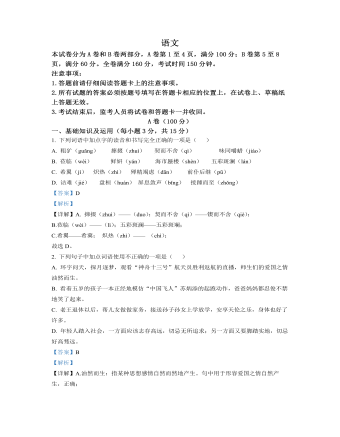
2022年四川省内江市中考语文真题(解析版)
见渔人,乃大惊,问所从来。具答之。便要还家,设酒杀鸡作食。村中闻有此人,咸来问讯。自云先世避秦时乱,率妻子邑人来此绝境,不复出焉,遂与外人间隔。问今是何世,乃不知有汉,无论魏晋。此人一一为具言所闻,皆叹惋。余人各复延至其家,皆出酒食。停数日,辞去。此中人语云:“不足为外人道也。”
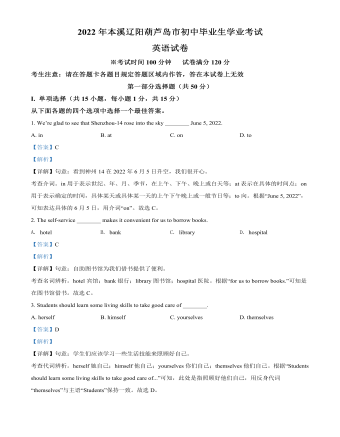
2022年辽宁省本溪市、辽阳市、葫芦岛市中考英语真题(解析版)
A bird went to look for happiness. On ___21___ way, she saw a flower, the flower was short ofwater, but his face was full of ___22___ .
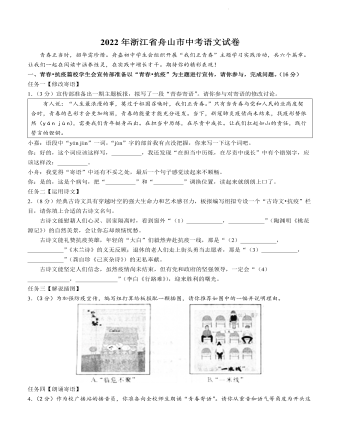
2022年浙江省舟山市中考语文试卷
生平所见之友,以穷以老而遂于衰颓者,十居七八。赤豹②,君子也,久居江东,得无有陨获③之叹乎?昔在泽州,得拙诗,深有所感,复书曰:“老则息矣,能无倦哉?”此言非也。夫子“归与归与”④,未尝一日忘天下也。故君子之学,死而后已。
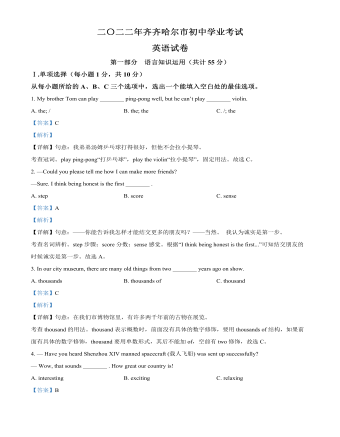
2022年黑龙江省齐齐哈尔市中考英语真题(解析版)
B: For 3 days. I expect togo there again.A: Lucky you. I had to stayat home. But I’m planning to travel to Mount Changbai.B: Oh, that’s a good place.I went there three years ago.
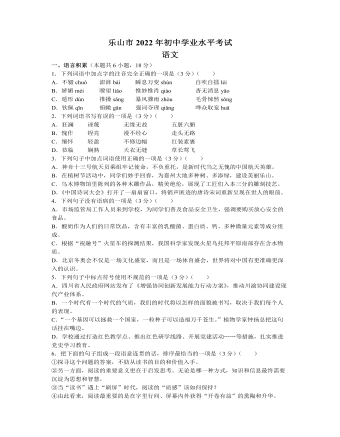
2022年四川省乐山市中考语文真题
中华民族拥有5000多年灿烂文明。弘扬中华美育精神,用美育涵养“美丽心灵”,不妨从教育引导年轻人热爱艺术开始。年轻人通过认识和理解中华大地上的优秀艺术作品,可以形成开阔的视野和包容的心态,增强文化自觉和文化自信。引导年轻人接近、欣赏中国文艺作品之美,有助于赓续优秀文化传统,增强做中国人的志气、骨气、底气。
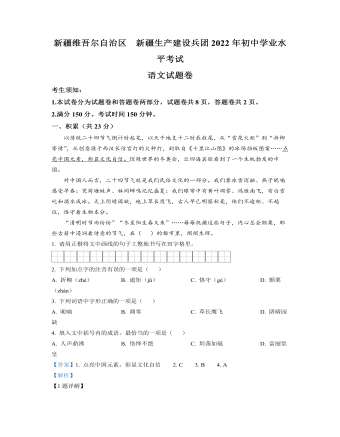
2022年新疆中考语文真题(解析版)
尊敬的李教授:我校读书节活动将于4月25日在图书馆拉开帷幕。读书节期间,①学校将开展征文比赛、读书交流会、课本剧表演等。②您对名著阅读的研究确实有点水平,学校③特邀您开设《傅雷家书》阅读方法专题讲座,请您百忙之中参加为盼!
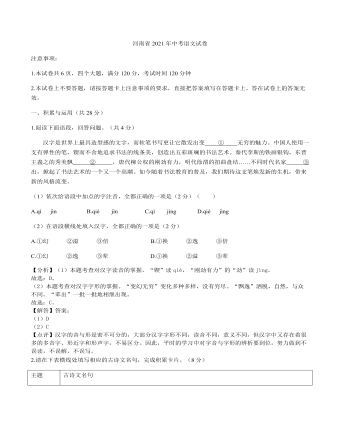
2021年河南省中考语文真题(解析版)
班长立刻组织抢修舵链,这才发现,几乎不可能。修舵链要从船头的铁柱处下去,可甲板到船头的舱盖上结了厚冰,舱盖是拱形的,十多米长。平时,船一晃,在上面走都很难。现在结了冰,站都站不住,根本别想走过去。班长看着结冰的舱盖请示陪同的马参谋长:“参谋长,过不过?”“怎么过?”“爬!”“多大把握?”“没有。”马参谋长认真看了看班长,重重拍了他一下。
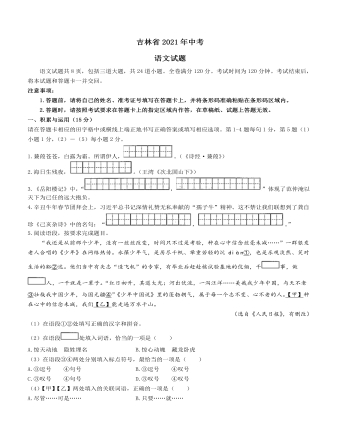
2021年吉林省中考语文真题(答案版)
出佛手园,远处有山,山中有岚,有云。岚清,云白,绸缎一般,棉花一般,曼妙而行,逍遥自在。除了爱,还有眼前这山川草木。小小人类身处自然,永不孤单。那些草木,那些动物,那些自然界中的生灵,各安其所,相处自洽。而人类,不免焦虑,屡屡焦虑,内在小宇宙紊乱,何不走到自然中,谦卑蹲下,去学习一株草、一颗露珠的宁静?
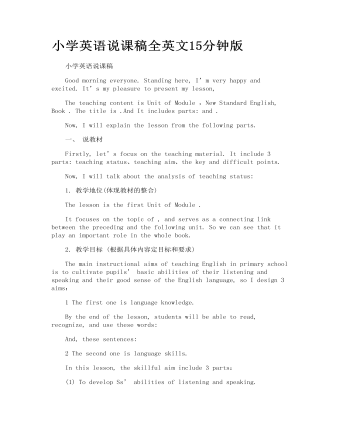
小学英语说课稿全英文15分钟版
一、 说教材 Firstly, let’s focus on theteaching material. It include 3 parts: teaching status、teachingaim、the key and difficult points. Now, I will talk about the analysis of teaching status: 1. 教学地位(体现教材的整合) The lesson is the first Unit of Module . It focuses on the topic of , and serves as a connectinglink between the preceding and the following unit. So we can see that it playan important role in the whole book. 2. 教学目标 (根据具体内容定目标和要求) The main instructional aims of teaching English inprimary school is to cultivate pupils’ basic abilitiesof their listening and speaking and their good sense of the English language,so I design 3 aims:

2022年内蒙古赤峰市中考语文真题(解析版)
题稚川山水【唐】戴叔伦松下茅亭五月凉,汀沙云树晚苍苍。行人无限秋风思,隔水青山似故乡。注:戴叔伦,唐代诗人,此诗作于作者宦游途中。
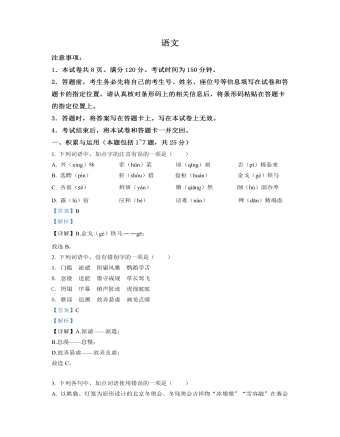
2022年内蒙古包头市中考语文真题(解析版)
夜来似闻某人素心,明日试往看之,入其门,窥其闺,见所谓某人方据案面南看一文书。顾客入来,默然一揖,便拉袖命坐,曰:“君既来,可亦试看此书。”相与欢笑。日影尽去,既已自饥,徐问客曰:“君亦饥耶?”不亦快哉!
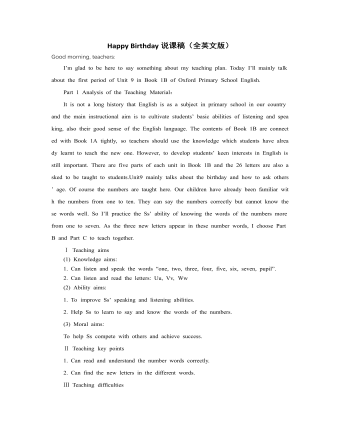
人教版新课标PEP小学英语三年级上册Happy Birthday(全英文版)说课稿
1. Do some exercise on the paper. There are four kinds of exercise here. The exercise 1 is to develop Ss’ ability of listening. Exercise 2 is to practice Ss’ ability of knowing the words. Exercise 3 is to develop Ss’ ability of speaking numbers and letters. Exercise 4 is to make Ss know the words and letters well. These exercises can consolidate the new knowledge from different styles of problems.2. Then tell Ss that we can sing the numbers like “ Do, re, mi, fa, so, la, ti, do” and let them listen to a song named “Do, Re, Mi”. Add some extra knowledge so that Ss will be glad to see that the numbers can be used in another way.Step 4 Homework1.Read the numbers from 1 to 7 and 7 to 1 five times.2.Read the letters “u, v, w” five times follow the tape.Reading is a useful way for the Ss of Grade One to practice the knowledge. Ask Ss to imitate reading from the tape in order to make Ss have a good habit of listening and let them have a better pronunciation.Step 5 Board writingI ‘ll put the seven numbers like a scale(音阶)as I’ll let Ss know that we can sing out the numbers. When it comes to listen to the song, I ‘ll draw a musical note on Bb. Unit 9 Happy birthday!sevensixfivefourthree U u V v W wtwo pupil five windowoneThat’s all for my class designing. Thank you for listening!
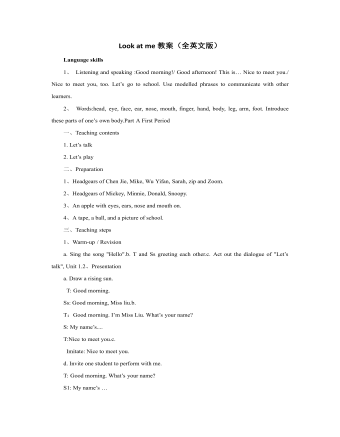
人教版新课标PEP小学英语三年级上册Look at me教案(全英文版)
3、Practicea. Nice to meet you. Nice to meet you,too.b. Perform the dialogue.c. Arrange the dialogue according to the pictures or sentence cards.d. Let’s play.A: Good afternoon,B. This is C. Hello, C! Nice to meet you.C: Nice to meet you, too.A,B: Goodbye!C: Bye!4、Assessment Workbook page 10Add-activitiesa. Listen to the recording and repeat.b. Make a dialogue according to "Let’s talk".Second Period一、Teaching contents1. Let’s learn Words:body, leg, arm, hand, finger, foot.1. Let’s do二、Preparation1、a puppet2、Cards of body, leg, arm, hand, finger and foot.3、headgear of a captain三、Teaching steps1、Warm-up/ Revisiona. Captain says to review "let’s do" of Part A.b. Perform the students their own dialogues.2、Presentationa. Learn to say "body, leg, arm, hand, finger and foot."b. Listen to the recording and repeat.c. Let’s do. Clap your hands. Snap your fingers. Wave your arms. Cross your legs. Shake your body. Stamp your foot.3、Practicea. Let’s draw a person.b. Let’s do. Point out which picture.c. Let’s do. Who responses faster.4、Assessment Workbook page 115、Add-activitiesa. Listen to the recording, repeat and act out.b. Say all the names of the body to your parents.Third Period一、Teaching contents1. Let’s check2. Let’s chant二、Preparation1、stationeries1、pictures of parts of Zoom
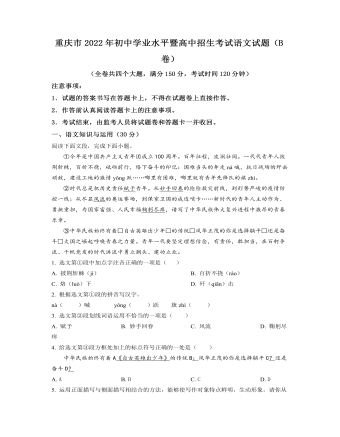
2022年重庆市中考语文试卷(B)及答案
在厨房蒸馒头的母亲,揭开锅盖高兴地说到:“馒头笑了。”我没看出来,就问她怎么笑的。母亲说:“就是馒头开口了,过年了,讨个吉利,所以要说笑了才行。”
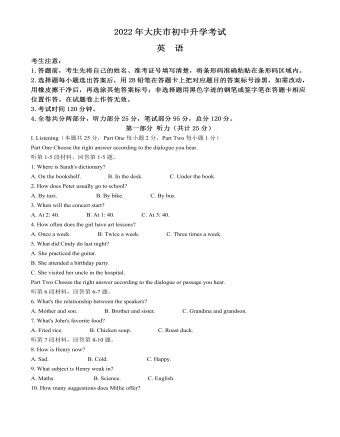
2022年黑龙江省大庆市中考英语试题(解析版)
On a snowy day, there was a man walking in ahurry on the road. His clothes were in poor condition. You might think he was abeggar(乞丐),but in fact he was a painter. His name was Vincent Willem van Gogh.
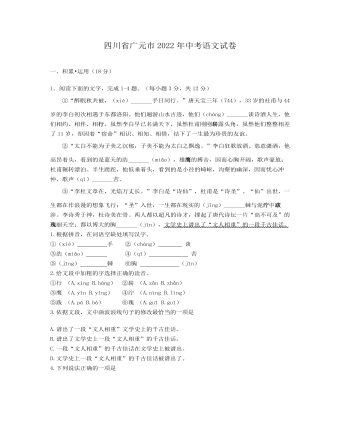
2022年四川省广元市中考语文试卷及答案
予谓菊,花之隐逸者也;牡丹,花之富贵者也;莲,花之君子者也。噫!菊之爱,陶后鲜有闻。莲之爱,同予者何人?牡丹之爱,宜乎众矣。

2019年北京市中考语文试题试卷含答案解析
舜发于畎亩之中,傅说举于版筑之间,胶鬲举于鱼盐之中,管夷吾举于士,孙叔敖举于海,百里奚举于市。故天将降大任于是人也,必先苦其心志,劳其筋骨,饿其体肤,空乏其身,行拂乱其所为,【甲】所以动心忍性,曾益其所不能。